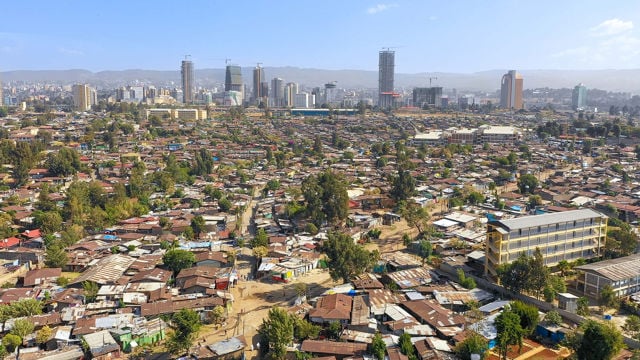The world is heading in the wrong direction: Stagnation in the fight against extreme poverty

For the second year in a row, new figures from Norad show that poverty levels have stalled. The world is now heading in completely the wrong direction when it comes to achieving the UN goal of eradicating extreme poverty by 2030.
On the International Day for the Eradication of Poverty, Norad presented a new report that provides a status update and an analysis of the developments in global poverty. The calculations in the new report show that around 700 million people lived in extreme poverty in 2023.
This means that they have less than NOK 22 per day available to live on, adjusted for purchasing power.
“The situation is highly critical for the world’s poorest people. We can imagine what it is like to live on less than NOK 22 per day,” says Håvard Mokleiv Nygård, Director of Knowledge at Norad.
From optimism to stagnation
In the early 2000s, the world was characterised by progress and optimism. During the 2000-2013 period, we experienced an annual decline in poverty of around 75 million people. However, this decline slowed to only around 25 million annually as early as the 2013-2019 period.
“The findings in the report emphasise just how off course the world is when it comes to achieving SDG 1 on eradicating extreme poverty by 2030. There are still more people living in extreme poverty now than there were before the pandemic and the annual decline has slowed down even further,” says Nygård.
Poverty could persist for decades to come
The world is characterised by war, conflict, high cost of living and climate crisis. For many low-income countries, these crises are occurring alongside the consequences of the coronavirus pandemic, which represented a major setback.
The African continent is worst affected. The report shows that nine of the ten countries with the highest proportion of people living in extreme poverty are situated in sub-Saharan Africa. Between 50 and 70 per cent of the population in these countries live below the extreme poverty threshold.
“Economic growth is the engine in the fight against poverty. Historically, growth has contributed to 90 per cent of the decline. Now, growth is weaker and has limited effect. Increased funding and the political will to channel more resources towards the eradication of poverty are needed. In the absence of this, poverty levels will stagnate or, worse, increase,” Nygård explains.
“At this point in time, we are running on empty and heading in the wrong direction. Without a radical change in direction and a significant increase in funding for the eradication of poverty, extreme poverty will persist at high levels for decades to come. It is now crucial for the international community not to forget about the eradication of poverty,” says Nygård.
Read the full report:https://www.norad.no/fattigdomsrapporten-2024
Main figures and findings in the report:
- The global decline in extreme poverty has almost completely stagnated. In 2023, around 700 million people lived in extreme poverty (on less than NOK 22 per day).
- The 2023 estimate means that poverty has declined by only around 10 million people since 2022. Globally, there are still more people living in extreme poverty than there were before the pandemic in 2019.
- The world is heading in completely the wrong direction for achieving the first sustainable development goal of eradicating extreme poverty by 2030. In many countries, extreme poverty may persist at high levels for several decades to come unless the world changes direction and contributes more funding.
- In light of the latest figures, the technical projections that indicate that there are around 550 million people living in extreme poverty may be too optimistic.
- The pandemic and wars have resulted in major setbacks, but other more fundamental factors have also slowed down progress and need to be addressed in order to achieve progress again. Following an annual decline of around 75 million in 2000-2013, the decline slowed down to a third of this (around 25 million) as early as the 2013-2019 period.
- The causes include a combination of a world economy in disarray, with inflation and reduced will to finance and invest, more stubborn poverty and fundamental traits associated with the countries in which poverty remains high.
- Nine of the ten countries with the highest proportion of extreme poverty are located in sub-Saharan Africa. In these countries, somewhere between half and three quarters of the people live below the extreme poverty threshold. Eight of the ten countries with the highest proportion of people living in extreme poverty can also be found in this region.
- Sub-Saharan Africa also has elements of vibrant business and industry and there is great potential in the region. Nevertheless, too little has been done to develop the conditions for the poorest people to be included, despite high economic growth through education, infrastructure and other framework conditions.
- The weak progress is vulnerable to new setbacks. Many poor people live just below the international extreme poverty threshold. For every twenty cents by which the threshold is raised, the number of people living in extreme poverty increases by around 160 million, which illustrates the vulnerability to setbacks with more people living below the poverty threshold.
About the report
- The report provides a status update on developments in global poverty, trends and what it will take to reverse developments. This is the second successive year in which Norad has published a report on International Day for the Eradication of Poverty, 17 October.
- In addition to a general section discussing the status of global poverty and what it will take to turn the tide, the report also takes a detailed look at the situation in four different countries: Mozambique, Ghana, DR Congo and Uganda.
- The main emphasis in the report is on the international threshold for extreme poverty, which defines extreme poverty as consumption of less than USD 2.15 per day adjusted for purchasing power, which corresponds to around NOK 22.